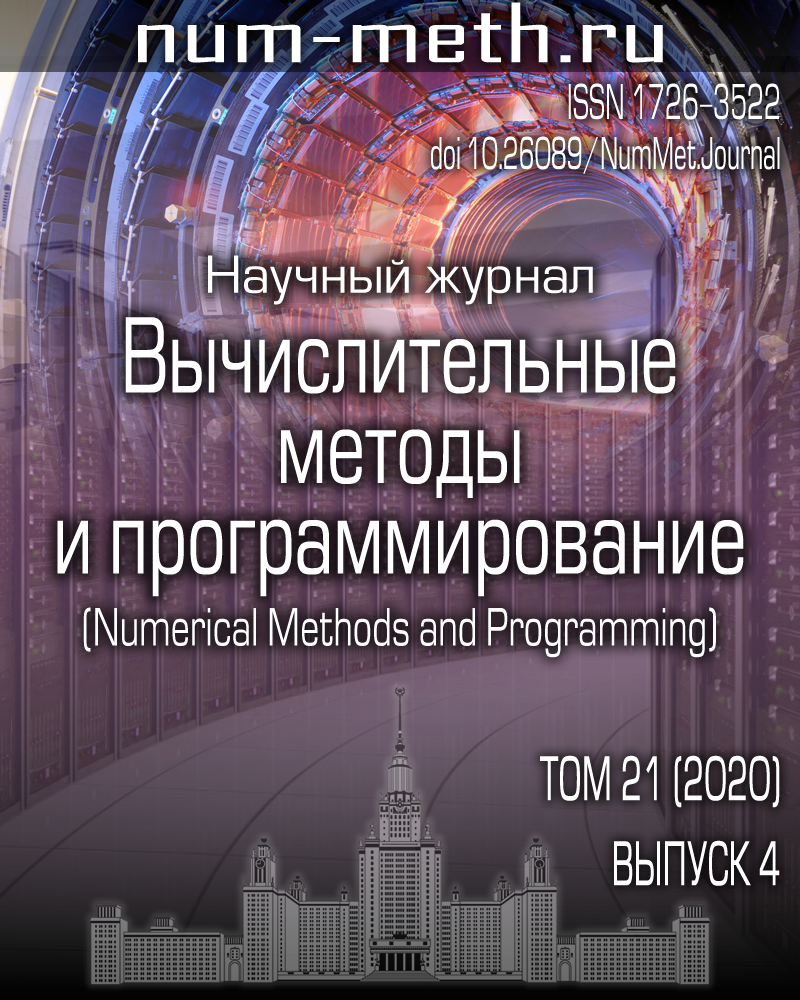DOI: https://doi.org/10.26089/NumMet.v21r431
Об анализе устойчивости течений жидкости в канале эллиптического сечения с применением метода конечных элементов на неструктурированной сетке
Ключевые слова:
Аннотация
Существующая технология численного анализа устойчивости течений вязкой несжимаемой жидкости в каналах постоянного сечения была ранее расширена на случай локальных пространственных аппроксимаций на неструктурированных сетках, приводящих к задачам с большими разреженными матрицами. Для пространственной аппроксимации при этом используется метод конечных элементов, а для решения частичных проблем собственных значений, возникающих при исследовании устойчивости течений, эффективный метод ньютоновского типа. В данной работе проводится подробное численное исследование предложенного подхода на примере двумерной конфигурации — течения Пуазейля в канале эллиптического сечения. Работоспособность подхода демонстрируется для широкого диапазона отношений длин полуосей сечения вплоть до отношения, при котором данное течение становится линейно неустойчивым. Показана сходимость ведущей части спектра по шагу сетки и совпадение результатов с результатами, полученными на основе аппроксимации спектральным методом коллокаций.
Опубликован
Выпуск
Раздел
Библиографические ссылки
- A. V. Boiko and Yu. M. Nechepurenko, “Numerical Spectral Analysis of Temporal Stability of Laminar Duct Flows with Constant Cross Sections,” Zh. Vychisl. Mat. Mat. Fiz. 48 (10), 1731-1747 (2008) [Comput. Math. Math. Phys. 48 (10), 1699-1714 (2008)].
- A. V. Boiko and Yu. M. Nechepurenko, “Numerical Study of Stability and Transient Phenomena of Poiseuille Flows in Ducts of Square Cross-Sections,” Russ. J. Numer. Anal. Math. Modelling 24 (3), 193-205 (2000).
- A. V. Boiko and Yu. M. Nechepurenko, “Technique for the Numerical Analysis of the Riblet Effect on Temporal Stability of Plane Flows,” Zh. Vychisl. Mat. Mat. Fiz. 50 (6), 1109-1125 (2010) [Comput. Math. Math. Phys. 50 (6), 1055-1070 (2010)].
- A. V. Boiko, K. V. Demyanko, and Yu. M. Nechepurenko, “Numerical Analysis of Spatial Hydrodynamic Stability of Shear Flows in Ducts of Constant Cross Section,” Zh. Vychisl. Mat. Mat. Fiz. 58 (5), 726-740 (2018) [Comput. Math. Math. Phys. 58 (5), 700-713 (2018)].
- N. V. Klyushnev, On Utilizing the Finite Element Method on Unstructured Meshes for Stability Analysis of Flows in Channels of Constant Cross-Section , Preprint No. 30 (Keldysh Institute of Applied Mathematics, Moscow, 2020).
- P. J. Schmid and D. S. Henningson, Stability and Transition in Shear Flows (Springer, New York, 2001).
- A. V. Boiko, A. V. Dovgal, G. R. Grek, and V. V. Kozlov, Physics of Transitional Shear Flows (Springer, Dordrecht, 2012).
- B. Fornberg, “A Pseudospectral Approach for Polar and Spherical Geometries,” SIAM J. Sci. Comp. 16 (5), 1071-1081 (1995).
- K. V. Demyanko, “Numerical Model for the Investigation of Hydrodynamic Stability of Shear Flows in Pipes of Elliptic Cross-Section,” Russ. J. Numer. Anal. Math. Modelling 34 (6), 301-316 (2019).
- P. J. Schmid and D. S. Henningson, “Optimal Energy Density Growth in Hagen-Poiseuille Flow,” J. Fluid Mech. 277, 197-225 (1994).
- J. Shen, “Efficient Spectral-Galerkin Methods III: Polar and Cylindrical Geometries,” SIAM J. Sci. Comput. 18 (6), 1583-1604 (1997).
- M. D. Gunzburger, Finite Element Methods for Viscous Incompressible Flows (Academic Press, Boston, 1989).
- K. V. Demyanko, Yu. M. Nechepurenko, and M. Sadkane, “ A Newton-like Method for Computing Deflating Subspaces,” J. Numer. Math. 23 (4), 289-301 (2015).
- K. V. Demyanko, I. E. Kaporin, and Yu. M. Nechepurenko, “Inexact Newton Method for the Solution of Eigenproblems Arising in Hydrodynamic Temporal Stability Analysis,” J. Numer. Math. 28 (1), 1-14 (2020).
- V. Theofilis, “Advances in Global Linear Instability Analysis of Nonparallel and Three-Dimensional Flows,” Prog. Aerosp. Sci. 39 (4), 249-315 (2003).
- K. V. Demyanko and Yu. M. Nechepurenko, “Dependence of the Linear Stability of Poiseuille Flows in a Rectangular Duct on the Cross-Sectional Aspect Ratio,” Dokl. Akad. Nauk 440 (5), 618-620 (2011) [Dokl. Phys. 56 (10), 531-533 (2011)].
- K. V. Demyanko and Yu. M. Nechepurenko, “Linear Stability Analysis of Poiseuille Flow in a Rectangular Duct,” Russ. J. Numer. Anal. Math. Modelling 28 (2), 125-148 (2013).
- A. V. Boiko, N. V. Klyushnev, and Yu. M. Nechepurenko, Stability of Shear Flows over a Grooved Surface (Keldysh Institute of Applied Mathematics, Moscow, 2016). [in Russian],
doi 10.20948/mono-2016-klyushnev - A. V. Boiko, N. V. Klyushnev, and Yu. M. Nechepurenko, “On Stability of Poiseuille Flow in Grooved Channels,” Europhys. Lett. 111 (1), 14001.p1-14001.p6 (2015).
- O. A. Grigoriev and N. V. Klyushnev, “Stability of the Poiseuille Flow in a Channel with Comb Grooves,” Zh. Vychisl. Mat. Mat. Fiz. 58 (4), 595-606 (2018) [Comput. Math. Math. Phys. 58 (4), 581-592 (2018)].
- P. G. Drazin and W. H. Reid, Hydrodynamic Stability (Cambridge University Press, Cambridge, 2004).
- Yu. M. Nechepurenko, “On the Dimension Reduction of Linear Differential-Algebraic Control Systems,” Dokl. Akad. Nauk 445 (1), 17-19 (2012) [Dokl. Math. 86 (1), 457-459 (2012)].
- G. H. Golub and C. F. van Loan, Matrix Computations (John Hopkins Univ. Press, Baltimore, 1996; Mir, Moscow, 1999).
- C. Taylor and P. Hood, “A Numerical Solution of the Navier-Stokes Equations Using the Finite Element Technique,” Comput. Fluids 1 (1), 73—100 (1973).
- A. Logg, K.-A. Mardal, and G. Wells (Eds), Automated Solution of Differential Equations by the Finite Element Method (Springer, Berlin, 2012).
- A. Ribes and C. Caremoli, “Salomé Platform Component Model for Numerical Simulation,” in Proc. 31st Annual Int. Computer Software and Applications Conference (COMPSAC 2007), Beijing, China, July 24-27, 2007 (IEEE Press, Washington D.C., 2007), Vol. 2, pp. 553-564.
- R. R. Kerswell and A. Davey, “On the Linear Instability of Elliptic Pipe Flow,” J. Fluid. Mech. 316, 307-324 (1996).


